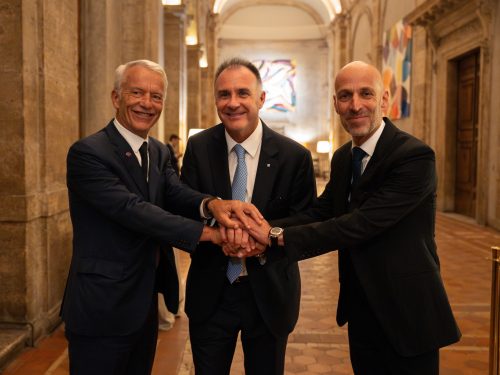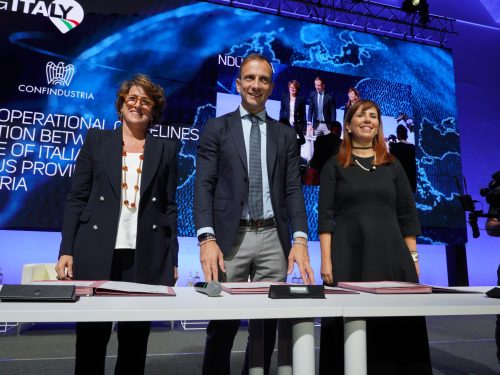Communiqué
Print
Share on
ECONOMIC ENVIRONMENT: BETWEEN TARIFFS, UNCERTAINTIES AND WEAK GROWTH
The Director General of Confindustria Maurizio Tarquini, during the hearing on the Draft Budget Law 2026, points to an even more uncertain global context than last year.
The triggering of the tariff spiral and geopolitical tensions have brought uncertainty to an all-time high: this puts pressure on value chains, curbs exports, reduces corporate margins and the confidence of households, which, despite the increase in real disposable income, keep saving for precautionary purposes. In such a scenario, the risk of losing production basehighlighted last year, is even more topical, not least because of the pressure to relocate to the United States exerted by duties, as well as for the continued self-destructive approach of European policies.
In Italy, the 256 thousand enterprises with more than 10 employeestogether with the 10 million workers occupying, contribute more than 80% to keeping our public finance and social protection system afloat. This is what is at stake.
The soundness of our accounts and political stability have favoured the reduction of sovereign spread and BTP yields by 1.18% from the end of 2023which will be worth, when fully operational, approximately 30 billion per year less interest expenditure on debtwith a savings of 5 billion already in the first year. This has also improved the perception of Italy in the markets and by the major rating agencies.
However, the growth remains weakAfter the vigorous post-pandemic recovery, the country has returned to 'zero point' levels and is struggling to regain momentum. Within this framework, the PNRR is playing a key roleIn addition to raising long-term growth, it has a countercyclical effect. Without its additional resourceswhich are driving investment, Italy would be in stagnation. Instead, we record a GDP growth, albeit modestboth this year and next. The economies of other European countries are also holding up thanks to huge public resources: the extraordinary investments in Germany, the large public budget deficit in France and the PNRR in Spain.
A ZERO BALANCE MANOEUVRE, AN EXTRAORDINARY INDUSTRIAL PLAN IS NEEDED
The DDL mobility resources of 21.3 billion in 2026, 18.8 in 2027 and 16.4 in 2028against coverage of 20.4 billion in 2026 (including the 5.1 billion from PNRR remodulation), 13.0 in 2027 and 9.6 in 2028. The result is a Essentially 'zero balance' manoeuvrewithout significant impact on GDP.
Confindustria acknowledges the government's readiness for dialogue which resulted in the sharing of important choices, primarily those on hyper-amortisation and Single European Economic Zone. It recognises that availability especially in the light of the narrow margins of intervention, indicated in the Public Finance Policy Documentwhich make the impact of the manoeuvre on next year's GDP zero. However, the DDL Budget lacks the right size to boost business competitivenesswhile hitting some relevant targets.
Precisely for this reason, already from our public assembly in Maywe put forward the need to provide Italy with a Extraordinary Industrial Planwhich would go beyond the limits of individual budget laws, suggesting three lines of action: investment, competitiveness and the attractive environment.
PNRR AND ENERGY COSTS: THE TWO REAL URGENCIES COMPLEMENTING THE MANOEUVRE
Today, we read the DDL Budget as the first stage of this journey and point to at least two others, which we consider priority to ensure financial size and focus adequate to the needs of enterprises: the PNRR remodulation and the containment of energy costs.
Reshaping the PNRR
As for the PNRR, we believe that its vocation to support productive investments should be strengthened and, by this route, to the social cohesion of the country. Starting from resources not spent on Transition 5.0we ask that remodulation be an opportunity to ensure that business support of at least 8 billion a year, for a three-year periodwhich we have indicated as a minimum target, also looking at what France and Germany are doing. In this remodelling, we hope that there will also be room for a strengthening of R&D creditwhich, from next year, will be reduced in its scope, with a concessionary rate of 10%.
Reducing the price of energy
In the first ten months of 2025 the average price in Italy was 116 €/MWh; compared to 87 in Germany, 65 in Spain and 61 in France. Compared to the US and China, energy costs us three to five times more. The high cost of energy erodes company margins and their ability to self-finance and capitalise. The propensity to invest and the price competitiveness of end products and services.
The Association urges immediate measures that do not affect budget balances:
- a measure to put new instruments based on long-term renewable energy contracts on track;
- decoupling of electricity and gas prices;
- elimination of the TTF/PSV spread weighing in at two billion a year on household and business bills;
- reduction of general system charges through securitisation mechanismswhich weighs a 40% on the cost of electricity bills borne by households and businesses, amounting to 10 billion per year.
The problem can no longer be postponedif we want to create the conditions for return to growth and structural innovation. The urgency of the measures on energy costs is also due to the fact that have no impact on budget balances and only require the will to act.
POSITION ON THE MAIN MEASURES OF THE MANOEUVRE AND NECESSARY ACTIONS
For Confindustria, the essential interventions were and remain four:
-
hyper-amortisation for technological/digital innovation in production processes;
-
stabilisation of the tax credit for the Single Economic Zone for Southern Italy;
-
relaunching the operation of development contractsreinforcing its financial allocations;
-
confirmation and strengthening of the SME Guarantee Fund.
1. Hyper-amortisation: positive measure, but no multi-year perspective
We believe that the new hyper-amortisation represent a first, partial, effort on the investment support front. Positively, the rule admits both the so-called assets 4.0tangible and intangible, both plants for self-generation of renewable energyby providing surcharge rates up to 220% e Simplifications for the determination of energy savings. However, the plant is still weakfor at least two reasons: duration limited to investments made in 2026 (or booked and delivered by 30 June 2027) e operation postponed until the adoption of an implementing measure. For investment planning we need broad, certain and predictable horizons. We expect, therefore, that the incentive is extended on a three-year basis and that take effect immediately, as from 1 January 2026. It is also important to clarify that investments started this year are also eligible for the hyper-amortisation, perhaps under regulation 5.0, which will not be concluded when the new regulation comes into force.
2. Single SEZ: extension much appreciated but clarification needed
We express a particular appreciation for the extension until 2028 of the tax credit for the Single SEZ for Southern Italywhich incorporates almost entirely a proposal by Confindustria. It is a choice that confirms the effectiveness of this model as leverage to boost competitiveness and investment in the Mezzogiorno.
Especially positive is the choice of overcoming the annual funding formula - among the main weaknesses of these instruments - with a three-year extension and a definite budgetalbeit decreasing over the years.
We do ask, however:
- explicit confirmation of time allocation criteria already adopted in the pastwith reference to the so-called Mezzogiorno tax credit, for example the valorisation of SALto generate positive effects on the investments in real estate;
- possibility of supplementing with resources from EU cohesion policy programmesif the credit recognised by the Inland Revenue is less than the amount due.
3. Development contracts: more resources and simplification needed
I development contracts represent a important leverage for major productive investments. They meet great interest by companies and determine positive impacts on employment, supply chain growth and territorial development. Today they struggle to take off, due to the investigation delaysbut especially of insufficient endowments. The planned appropriations (550 million in total over the three-year period 2027-2029) are judged inadequate to the needs and lower than in previous years. Confindustria calls for a strengthening of the measure to give continuity to the realisation of new industrial projects.
4. SME Guarantee Fund: must be made structural
The SME Guarantee Fund is one pivotal instrument of economic policy and support of access to credit for SMEsand has contributed to business growth, especially in difficult economic times. It is necessary first of all confirm the Fund's current operating rulesin force until 31 December 2025. Moreover, according to available estimates, this confirmation should not require an additional allocation of resources.
We believe that in order to facilitate effective investment planning by SMEs, these rules should be made structural rather than renewed from year to year. The role of the Fund is then strengthenedparticularly in support of more structured companies and of alternative finance operations.
Finally, it is necessary eliminate the provision, not yet implemented, which provides for a additional premium for banks using the Fund's coverage beyond a certain threshold, which could generate tensions in relations between banks and companiesresulting in a higher cost of credit o a lower propensity of banks to provide unsecured credit.
PENALISING AND UNCERTAIN TAX MEASURES
The Manoeuvre - and this is not new this year - also features some unexpected criticalities. These are interventions that undermine taxpayers' confidence, the legal certainty e the positive impact of investment support measures.
Criticism of the new tax measures included:
- the tightening of taxation of intra-group dividends (the introduction of full taxation at the 24%in the presence of holdings of less than 10%, instead of the1.2% actual). This discipline is also disruptive compared to what happens across the border, where similar exemption systems are adopted, and will radically change the ownership structure of Italian groups, penalising our ability to maintain and attract capital;
- the prohibition, as from 1 July 2026, of using tax credits on the F24 form to offset debts for INPS social security contributions and INAIL insurance premiums. A very impactful measure, especially for companies with a large number of employeeswhich make a lot of contribution payments, and with a low level of profitability due to major investments or losses. The risk is that the freezing of compensation freezes liquid resources and reduces the operational capacity of companies. The new ban will effectively limit the possibility of using instruments that are now central to companies' investment policiessuch as the tax credits ZES, 4.0, 5.0, R&D. It is, however, an intervention with retroactive effects. We therefore call for a comprehensive reassessment of the intervention.
ON LABOUR POSITIVE SIGNALS BUT NON-STRUCTURAL MEASURES
At work, I am appreciablein principle, the measures to support workers' purchasing power and to accompany the renewal of collective agreementsguaranteeing a favourable tax regime on salary increases related to inflationary dynamics. It is, however, a matter of non-structural measureswhich in themselves produce an effect of uncertainty on the business sideas they do not know whether they will be able to rely on them in the coming years.
The provision on contract renewals can generate unequal tax treatment between employeesdepending on when the contractual renewals are (were) concluded. A similar disparity could also arise at the negotiating level between different branches or sectors, depending on when the social partners sign the contract renewals.
Le measures on performance bonuses represent a positive sign of attention to variable paybut they risk reduce the incentive to convert to corporate welfare and have a scope limited to more structured companiesconsidering that the new limit (EUR 5,000) is higher than the average premium paid by the industry sector. It would have been preferable to simplify the requirements for access to substitute taxationregardless of the rate applied, given the difficulties of many companies at this time.
Then there is the the need for a specific tax relief for recruitment by large companies in the Mezzogiornorelated to investment plans attributable to the ZES tax credit. The absence of this measure continues to be a structural limitation of the plan to revitalise the Mezzogiornoas it deprives it of an important driving force for strengthen production chains and recover gaps.
In addition, the expansion contract instrument should be extended to the benefit, in particular, of larger companies engaged in industrial transformation processes. Failure to refinance this measure would, in fact, deprive these companies of a useful tool to accompany the employment transitions within the reindustrialisation and reorganisation processes.
On the subject of social security and, in particular, of pension fundsthe attempt to give a signal to give a political direction to open up investment in infrastructure and business. But, for truly mobilise retirement savings for the benefit of Italian infrastructure and enterpriseseven unlisted ones, favourable tax measures are also neededas well as a revision of the rules governing the system of supplementary pensionsin order to strengthening its governance and competences.
HEALTH AND RESEARCH: GOOD SIGNALS, BUT OPEN KNOTS REMAIN
It is certainly positive increase in expenditure ceilings for the purchase of medicines, medical devices and services from accredited private providers. It is recognised the strategic centrality of the life sciences sector to meet the health needs of citizens, although increases are still insufficient in relation to needs.
However, the payback issue. The DDL deletes the 1.83% levy fee payable by pharmaceutical companies for the sale of drugs to the NHS, but does not solve the problem of hospital expenditure, nor that of medical devices. A structural response to roofs is therefore needed e solve the payback issue borne by the main sectors of the supply chain.
PRIVATE INVESTMENT SUPPORT MEASURES: GOOD REFINANCING OF NEW SABATINI AND ALLOCATION OF RESOURCES FOR INTERNATIONALISATION
As for the private investment support measures è positive refinancing of the facilities granted under the so-called Nuova Sabatini e the allocation of resources to support internationalisation. It then appears of interest - although it budget is small e there is a lack of information on the specific modalities of intervention - the provision of contributions to private entities for interventions aimed at reduce exposure to risks affecting the national territoryIt is essential that the layout is aimed at supporting investments in prevention and protection of companies subject to the obligation to subscribe policies against catastrophic risks.
NO MEASURES ON HOUSING EMERGENCY, INDUSTRIAL RESEARCH AND INTERMODAL LOGISTICS. REVIEW NEW AGCOM FINANCING SYSTEM
They are missing, however, specific measures to tackle the housing emergency which, among other effects, has that of hinder the territorial mobility of workers e displacing the matching of labour supply and demand. The DDL allows the use of a share of the European Social Fund for climate also for the initiatives of the Piano casa Italy provided for in the Budget Law 2025, but does not provide for, as urged by Confindustria, financial and fiscal measures, without prejudice to the need also to urban simplifications to promote the realisation of accommodation for low-income workers, students, the elderly.
Also worth mentioning is theabsence of measures for industrial research and intermodal logistics (ferrobonus, sea modal shift). Useful tools to enhance the connectivity and logistics within our country and with foreign countriesAlso of note is the lack of resources to cover the costs of the new collective agreement for local public transportthat the sector is unable to absorb.
Finally, the wish is expressed that reviewing AGCOM's new financing system, which shifts the functioning of the Authority entirely to the regulated industryincluding a very wide audience of interested operators.
WITHOUT GROWTH WE WILL NOT BE ABLE TO GUARANTEE CURRENT WELFARE LEVELS
Confindustria concludes the speech with a invitation to reflection and action.
We must not, nor can we, resign ourselves to the zero-point syndrome. If Italy does not grow, the problem is not only of companies, but collective. The country's ability to build a future worthy of the present depends on itmade up of achievements that we too often take for granted and which, in fact, are not.
We wish to reiterate this: without growth, i.e. without the companies that make it, we will no longer be able to ensure social protection levels from which we benefit today. It means less education, health, welfare, assistance to the weakestjust to mention a few examples. And the fact that companies stay or come here to Italy, to invest and bet on that futureis another fact that we cannot, and should not, take for granted.
It depends on our choicesat least on some, we hope there will be the broader convergence of political forceswithout the constraints of seeking electoral consensus.
La stability of accounts is a 'good choice'but must be accompanied by a significant and stable investment over time in companies and their ability to compete. Therefore, we ask coherent choices on at least three chapters complementary to the manoeuvre:
- the PNRR remodulation;
- measures to reduce the cost of energy;
Le zero-cost reforms. After one year, some 80 proposals from Confindustria, those approved are 9 e 8 more are in the home stretch. We are aware of the obstacles to which simplification policies go, but we encourage Parliament, Government and Regions to do more.
We want a simpler Italy, i.e. a place where risk-takers can rely on non-hostile and stable rules.
















